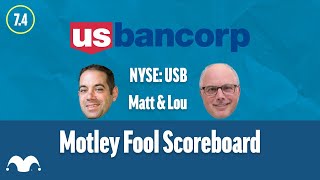
U.S. Bancorp building in Portland, Oregon.
In past articles, I've discussed the importance of the efficiency ratio when it comes to identifying great bank stocks. I was recently reminded of this point when reading through a presentation given by one of the best bank CEOs in America, Richard Davis of U.S. Bancorp.
The obvious reason a low efficiency ratio is important is because it reflects the percentage of revenue consumed by noninterest expenses. If the ratio is high, then too little revenue converts into income, which leads to lackluster profitability. If the ratio is low, then the opposite is true.

While most banks strive for a ratio in the 50%-60% range, only a handful of them accomplish the objective on a sustainable basis -- U.S. Bancorp being one of them. For the first nine months of the year, its efficiency ratio came in at 52.8%.
But beyond exerting a direct impact on earnings, what's so critical to appreciate is that efficiency has large indirect effects on other areas of a bank's operations as well.
Risk management is a prime example.
As I showed last month, there's a strong correlation between a bank's efficiency ratio and its nonperforming loan ratio. Namely, banks with higher efficiency ratios have a tendency to write worse loans.

I noted at the time that this correlation seems to follow from the fact that a bank's objective is to maximize return on equity. If this objective is hindered by low efficiency, then the slack must be made up through other means. And the easiest way to do so is to write higher yielding, and thus riskier, loans.
Columbia business school professor Charles Calomiris touched on this point in his book Fragile by Design: The Political Origins of Banking Crises & Scarce Credit: "Given an environment in which risk-taking with borrowed money was considered normal, it is easy to understand why some bankers, particularly those who were having trouble competing against more efficient rivals, decided that the right strategy was to throw caution to the wind."
Another aspect of operations indirectly affected by the efficiency ratio is a bank's credit rating and thus cost of funds. This is the point Davis made in his recent presentation.
Here's what he had to say about the fact that U.S. Bancorp has the best debt ratings of any bank in the industry (emphasis added):
We're very proud of those debt ratings and yet we have to do a lot to protect those that ratings as you would guess. If you switch places with me and you talked to 67,000 employees there's a lot of things to make them proud of. [Our debt ratings are] one of the most important things that they earn every day and yet it's one of the hardest things to convey to them how important that is and what it really means and where it comes from. And so one of the reasons why I talked about things like [keeping payroll costs down] and explain to them what we're doing when we do that, we're protecting the company's quality; we're protecting things like debt ratings which matter so much to pricing and reputation and in this case quality.
Not to belabor the point, but here's the logical chain that connects the efficiency ratio to debt ratings and the cost of funds: If a bank has lower expenses, then its profitability is likely to be higher; and if a bank's profitability is higher, then its ability to service debt goes up, which is what credit ratings are meant to communicate. Moreover, if a bank's credit ratings are higher, then its cost of funds is lower, which fuels profitability even more.
The point is this: For investors interested in identifying bank stocks with the best chance of outperforming the industry, then the first place to look (for many reasons) is the efficiency ratio.






